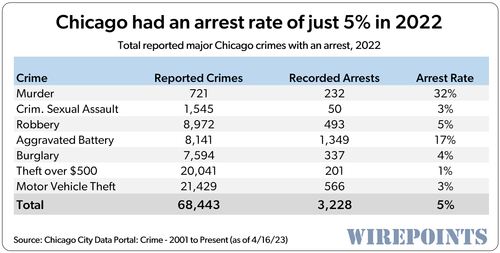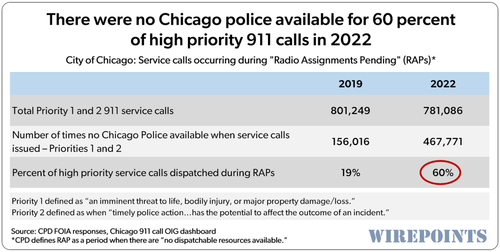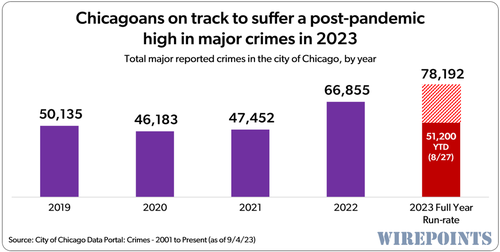Chicago Criminals Get Green Light To Rob, Loot And Steal As Odds Of Punishment Collapse To Near Zero
By Ted Dabrowski and John Klingner of Wirepoints
The decision to commit a crime in Chicago has never been easier. Criminals are almost guaranteed to profit because the chances of getting caught and punished have collapsed to near-zero.
It’s a big reason why the city is on target to hit a post-pandemic high in major crimes in 2023, currently up 32 percent vs. last year. It’s also why crime is unlikely to slow down significantly any time soon. Mayor Brandon Johnson doesn’t show any signs of imposing a higher cost on the city’s criminals. And Cook County State’s Attorney Kim Foxx and Cook County Chief Judge Tim Evans haven’t changed their soft approach to crime either.
The math is pretty straightforward. A demoralized, restricted police force. Plus a 1 in 20 arrest rate. Plus a high rate of unreported crime. Plus a dismal 911 response rate. Plus a city leadership that’s soft on crime. All that equals a near-zero chance of criminals ever getting punished.
Not until the costs of committing crime go way up – and the equation changes – will Chicagoans see any relief.
Equation inputs
Arrests
The chance of getting arrested in Chicago for a major crime collapsed to just 5 percent in 2022. It was already a low 10 percent just four years ago.
More than 68,000 major crimes were reported in Chicago last year. Only 3,228 of them resulted in arrests. Wirepoints’ calculations are based on the Chicago City Data Portal: Crime – 2001 to Present.
The arrest rate for criminal sexual assault? Just 3 percent. Ditto for Motor Vehicle Thefts. Burglaries were at only 4 percent and Robberies, 5 percent.
For thefts over $500, the chance of getting busted is even lower, at just 1 percent. There were just 201 arrests out of 20,041 crimes reported last year. And you’ll avoid arrest 96 times out of 100 across any form of theft, which The New York Times recently reported.
Unreported crimes
It gets even better for Chicago criminals. The above data is just for crimes that are actually reported. The Bureau of Justice Statistics found that nationally in 2019, “Only 40.9% of violent crimes and 32.5% of household property crimes were reported to authorities.” So the real chance of getting caught is even lower than the 5 percent.
Soft-on-crime leadership
Criminals are far more likely to get verbal support for the crimes they’ve committed, not condemnation, from Mayor Brandon Johnson. Kids just being “silly,” he said of the city’s recent teen takeovers. They’re not “mob actions,” he argued. We captured both those moments here and here.
And there’s the fact that even if criminals do get caught, the chances of being convicted and sentenced are low. State’s Attorney Kim Foxx and Chief Judge Tim Evans continue their light treatment of felony weapons charges and issue plea deals on the cheap.
Criminals also know they’re less likely to be detained pre-trial, which Wirepoints covered in Close the revolving door for high-risk offenders in Cook County. There are about 800 more violent defendants out on electronic ankle bracelets at any one time – many of them felons – than there were in 2016. There are thousands more defendants out without any tracking.
With the SAFE-T Act now law, the number of alleged criminals back on the streets before trial will increase further.
911 calls
Yet another part of the calculus is the fact that Chicago’s police aren’t responding to more than half of the urgent 911 calls they receive, part of what are called RAPs, or Radio Assignments Pending. Last year we reported on the 2021 data, which showed just over half of all priority 911 calls weren’t immediately handled.
It was even worse in 2022. Of the more than 780,000 Priority 1 and 2 911 service calls, 60 percent had no Chicago police available to respond.
Those delays included:
-
Over 4,700 robbery-related calls, including 470 robberies in progress
-
Over 19,400 calls of batteries in progress
-
Nearly 2,000 reports of sexual assault, including 150 assaults in progress
-
Over 18,000 reports of a person with a gun
-
Over 1,200 reports of citizens shot
-
Nearly 1,000 reports of citizens stabbed
Making it worse
The simple calculus of Chicago’s criminals is clear when you look at the city’s latest criminal fad: robberies.
The ease of stealing cars like Kias and Hyundais, in combination with new laws prohibiting police from foot and car chases, has emboldened criminals even more.
Criminals are now using those stolen cars to go on robbery sprees neighborhood to neighborhood, sometimes committing as many as 20 robberies within hours of each other, confident they won’t get caught or even chased.
That’s resulted in headlines like these:
The story that perhaps best captures the restrictions placed on officers to do their jobs is in a recent article by CWB Chicago: At least 23 armed robberies reported Sunday as Chicago cops *again* see a robbery in progress, but don’t chase the offenders:
…CPD police officers on patrol and in a surveillance camera operations center witnessed an armed robbery in progress in the 6500 block of North Western Avenue. “I can see them right now,” the officer radioed. “They got long guns. There’s a unit on scene.”
That patrol unit tried to pull the Durango over as they snaked through the North Side. Officers said four men were inside the SUV with their faces covered, bearing at least one rifle. But not long after the unit started to chase the SUV loaded with armed, masked men who had just robbed someone as Chicago police officers watched, a CPD sergeant ordered the squad car to terminate their efforts to stop the Durango.
At least eleven people were robbed that night, including some after the police supervisor decided to let the group of armed robbers get away.”
More victims of crime
Add all the above and it’s easy to see why criminals face a near-zero risk of punishment.
That also helps explain why the city’s crime numbers continue to rise. Chicagoans have been victimized more than 51,000 times during the first 8 months of 2023 – already more than they were over the entirety of 2019, 2020 or 2021. Only homicides are down compared to last year, by 8 percent – a small decline compared to other major cities.
If the lawbreaking trend continues, 2023 major crimes will total 78,000, some 17% more than in 2022.
For sure, there’s a lot to be done to solve the crime crisis in Chicago. The social challenges and poor educational outcomes plaguing the city will take years, if not decades, to unwind.
But to save lives in the meantime, and to make Chicago safer – one of Mayor Johnson’s key goals – the near-zero cost of committing crimes must rise dramatically. And that means reforging the chain of criminal justice, from arresting to prosecuting to sentencing.
Tyler Durden
Tue, 09/05/2023 – 19:40
via ZeroHedge News https://ift.tt/rDuZzKU Tyler Durden



